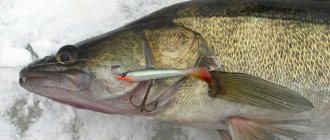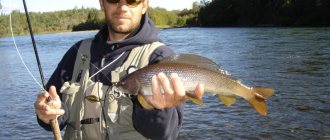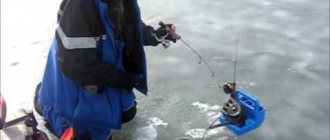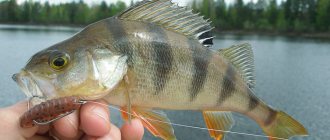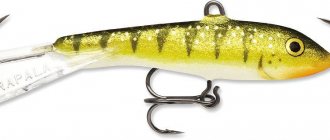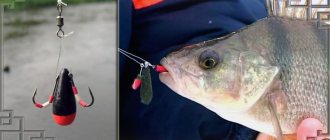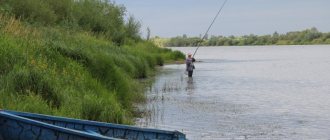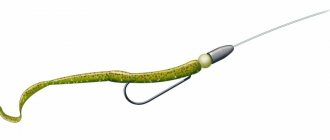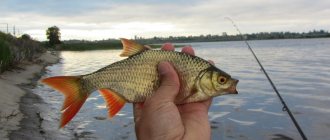Today the fishing market offers a wide range of baits for ice fishing. These are jigs, balancers, cones, spinners of various shapes, colors and sizes. Among all this diversity, amphipods stand out, which are especially popular among winter fishing enthusiasts.
This bait appeared quite a long time ago, more than 30 years ago. During this time, she experienced both ups and downs, the interest of the fishing fraternity in her increased and then faded, and now she has a second wind. Practice has shown that amphipods are capable of not only competing on an equal footing with modern spoons and balancers, but also surpassing them in terms of catchability in certain reservoirs. Therefore, it is not surprising that amphipods for winter fishing are in the arsenal of almost every winter angler.
Amphipod - what is it?
For those who prefer to fish exclusively in warm and comfortable seasons, the name “amphipod” is associated with a miniature freshwater crustacean, which is often used as bait. The winter bait amphipod has nothing in common with it; in appearance it looks like a small fish. They called it that because of the broken symmetry of the body (lateral tilt) and the wide action, which allows you to fish a large area under the hole. The most successful models, moving sideways in the water, pass a circle with a radius of up to one meter.
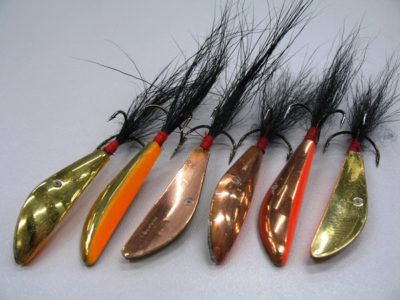
In the classic version, amphipod is an artificial fish weighing up to 20 g, length from 4 to 6 cm with a soldered tee in the tail. Its main distinguishing feature is the convexity of one of the sides, due to which the bait swims, slightly leaning on its side. To make it more attractive, the tail is decorated with a wool tassel. Hookiness is increased by using a treble on the belly, but an additional hook can negatively affect the game, so many anglers refuse it.
Amphipods are made from the same metals and alloys as most other winter baits. This, for example, could be lead or tin. Heavier models are used at serious depths and strong currents, and lighter models are used in calm shallow waters. In addition, depending on the size, weight and color, amphipods are distinguished for fishing for perch, for hunting pike perch or for purposefully catching pike.
This bait does not have a clear classification; all divisions are arbitrary. There are cast and soldered products, equipped with a single or triple hook. As for color, for example, amphipods for winter fishing for pike perch are usually silver-colored fish, as similar as possible to the prototype.
Design features of the bait
The amphipod spinner works on the same principle as a balancer , which plays in a horizontal plane, provided that there is a vertical suspension. The bait has a flat body with sides of varying thickness, which significantly affects its game: during the retrieving process, the lure from time to time rolls over to one side and then back.
In the central part of the invention there is a through hole that supplies fishing line with a tee. To stabilize the position, the ponytail is replaced with a tee hidden under a woolen tassel. Also, the bait does not have hooks in the front, which distinguishes it from a balancer.
If we look at the game, it is represented by a characteristic smoothness and uniformity, reminiscent of the behavior of a flat balance beam. If an upward movement is performed, the spoon creates powerful oscillatory vibrations in the horizontal plane, which causes extraordinary interest in the fish.
What predators can you catch?
Amphipods are also used in the summer (from a bridge or a watercraft), but still it is a winter bait intended for catching predatory fish using the vertical trolling method. Sometimes it catches peaceful inhabitants of rivers and lakes, such as bream or carp. A good catch is the perch, which greedily grabs the artificial fish and swallows it deeply, which creates certain problems when removing the hook. If you fish without a special leash, the pike will cut off the bait as luck would have it. Amphipods work great for winter fishing for pike perch, ignoring spinners, balancers and rattlins. The fanged one often attacks from the side of the head, so fruitless bites are common, but this only increases the excitement and desire to catch it.
Proper Wiring Technique
When using an amphipod spinner for perch in winter, it is customary to use 8x8 equipment The process involves performing 8 swings with eight-second pauses. If you break everything down, it will look something like this:
- The spoon must be lowered into the hole and fixed 15-20 centimeters from the bottom.
- Then it should be smoothly raised to a level of 50 centimeters, the movement should be suspended and the fishing rod should be sharply returned to its original position.
- After the tackle is in its original position, you need to wait about 8 seconds and repeat everything again. There should be no more than eight movements, because it is useless.
If a predatory fish swims near the hole, it will definitely become interested in the attractive action of the bait and try to pounce on it. At the same time, the bite force may not be entirely powerful. If the predator is active, then you need to continue fishing the hole. The main thing is to be patient and persistent, and this will be justified by a good bite.
Amphipod tackle and equipment for winter fishing
To fish with amphipods, you need to assemble a kit consisting of simple elements:
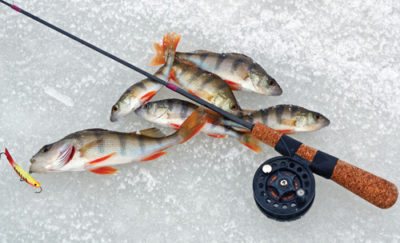
Rod. Usually this is a fishing rod up to 60 cm long with a hard or soft whip. If the product is straight, then it is better to choose a model with a rough tip. Some fishermen prefer to fish with a rod with a curved shaped handle, which allows them to make a high-quality hook with the movement of the wrist. In this case, it is desirable that the tip be soft.- Coil. A must-have piece of gear, especially in deep waters where a large supply of fishing line is required. Actually, storing fishing line is its main function.
- Monofilament. Anything can happen during winter fishing. It can be taken by a very large predator, which will have to be “starved out”, that is, released and carefully pulled up. Therefore, such a supply of fishing line is necessary so that the reel is at least three-quarters full. The diameter is selected depending on the size of the expected production, the optimal option is 0.18-0.20 mm.
- Leash. It is only necessary if there is an increased concentration of pike in the reservoir. The leashes are made of metal, with a special leash material, or fluorocarbon with a length of at least 15 cm. It must be said that due to the special installation of this bait, which will be discussed below, the leashes constantly bend, lose their shape, and fray.
As you can see, a fishing rod for fishing with amphipods is no different from the gear for fishing for perch or pike perch using spinners, brawlers, balancers and winter wobblers.
How to tie an amphipod?
There are several ways to mount an amphipod on the main line, but regardless of the one chosen, it is important to follow one rule: the bait must be fixed with the convex side up. If you put it in reverse, it will radically change the game. When thrown, it will sharply go to the side, and when it falls, it will tremble slightly, which is unlikely to please the predator.
How to fish with amphipods?
Catching perch with amphipods or pike perch in winter is carried out similarly to fishing with balancers or vibrations:
- 1. The bait sinks to the bottom of the reservoir.
- 2. Rises 20-30 cm from the bottom surface.
- 3. A series of swings of the fishing rod (5-10) are performed to set the fish to play. Between strokes you need to pause for 3-7 seconds - if we catch pike perch with amphipod, pike or perch, it is necessary for the bait to calm down. And only after that you can give her a new game.
- 4. If there are no bites, you need to change the fishing horizon and rise another 20-30 cm.
- 5. After a series of strokes, you can return to the previous depth.
Changing the horizon is done so that the fish can see the bait from different angles.
It is important to fish correctly with amphipods and show variety, because monotonous fishing is much less effective. It is recommended to periodically lower the bait to the bottom so that a cloud of turbidity rises. In many cases, the fish reacts quickly, and the bite follows almost immediately.
Fishing tactics
As with any other fishing, it all starts with searching for predator sites. According to the first ice, the most promising areas are considered to be river bends and the confluence of smaller water arteries. A large number of bites can come from channel edges, drops, exits from holes, and snags located at different depths. Pike and perch often go out to feed in the coastal zone, where they ambush fry among the remains of plants. In the middle of winter, when the so-called dead winter sets in, predators prefer to be in oxygen-saturated water - at great depths with the current, and closer to spring they return to the shore again, chasing squirrels.

On an unknown body of water, a useful device such as an echo sounder will help you find fishing spots. Without an electronic assistant, you will have to drill dozens of holes to find promising irregularities on the bottom. To catch one hole, 10-12 runs are enough; if the predator does not respond, you should not linger on it, you can move on to the next one.
It has long been known that feeding periods for different predatory species may not coincide. Pike and bersh, for example, prefer to feed at dawn. Perch becomes active during the daytime. By the way, at midday the toothy one can come out again. Well, the second half of the day, especially the last hours before sunset, is the best time for catching pike perch. You should take this into account when planning your fishing trip.
Making your own bait
Many novice fishermen are often interested in the topic of creating a “Bokoplav” spoon for pike perch. Making such a bait is not a very complicated procedure, so if you follow some rules and a step-by-step guide, everything will be very simple.
There are several manufacturing methods and instructions, but this one is considered the simplest and most accessible. From the materials you will need to take:
- A piece of polystyrene foam or foam rubber.
- A lead or tungsten pellet, about 4 millimeters thick.
- Hooks numbered 1 to 5.
At the first stage of manufacturing, you need to cut a blank from a foam or foam plate. Its thickness will be 2-3 millimeters. In this case, the product must be longitudinal. Next, you need to put the workpiece on the hook along its entire length, and after a few millimeters, pull the thread and cut it, leaving a tip about 5 millimeters long. It is this part that will be used as paws.
With the help of such a simple design, you can try to catch fish in a pond.
Complicated creation option
There is a second option for making amphipods, which involves the use of such materials and improvised means:
- Lead.
- A piece of wood.
- Polystyrene foam or any other product for the workpiece.
- Scissors, ruler and adhesive tape.
- Alabaster.
- Knife.
- Tee and hooks.
- Zelenka.
- Paint and brush for painting.
At the very beginning, you need to make a mock-up of the bait in a 1:1 size. You can use polystyrene foam as it has excellent buoyancy and is also affordable. It’s unlikely that you don’t have a few centimeters of foam in your shed. The main thing is that the workpiece is of high quality, otherwise the final product will not be able to demonstrate good catchability.
Next you will need to take a piece of wood and cover it on both sides with tape. This way you will create the so-called formwork, which will allow you to move on to the next step. By the way, the height of this formwork should not be less than 20 mm.
At the next stage, you need to prepare an alabaster solution and pour it into this form. Do not forget that such a substance can harden quickly, so after leveling the solution, the workpiece must be half immersed in it. Before this, it is pre-lubricated with a soap-based solution to make the workpiece easier to remove from the mold. Typically, it takes 15 to 20 minutes to completely cure. Once this time has expired, you can continue working.
Take a knife in your hands and make 2 indentations that will act as guides for the second half of the product. Using a soap solution, it is necessary to process the entire structure along with the workpiece, and then make a formwork from adhesive tape and fill it with alabaster.
As soon as it hardens, the two parts must be separated and the workpiece pulled out. Holes for filling are cut with a knife: there should be at least two of them. Air will come out of one when lead is poured into the other. After performing these steps, the filling form must be dried. The main thing is that it dries well enough. Do not speed up this process, as this may worsen the strength properties.
Final coloring
If you intend to create the Bokoplav spinner using the second method and have followed the above instructions, then next you need to paint the created blank green , possibly with brilliant green. In this case, it will be more attractive to fish.
The next step is to determine the center of gravity. The main thing is that after immersion in the water the bait should be with its nose slightly raised, and one of the ribs should be located higher than the other. Take this feature into account in advance, and only after that start drilling a hole for mounting.
Ultimately, it is necessary to give the bait an aesthetic appeal using a coloring agent. But before starting this work, the part must be cleaned of burrs or waste.
There are a wide variety of paint options, but each deep-dweller has his own personal preferences in this regard. If we are talking about catching perch or pike perch, then it is advisable to use bright lemon tones.
There is also one more important step to complete - form the tail and secure the tee. Having done this, the bait can be considered ready for use.
